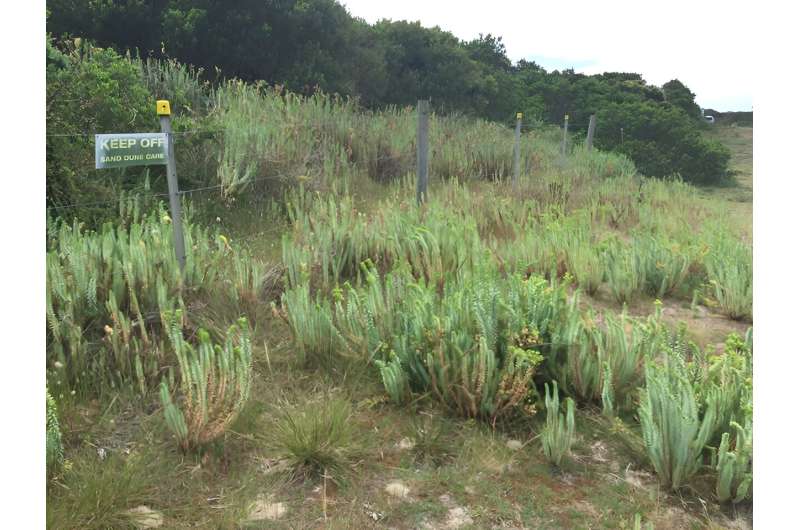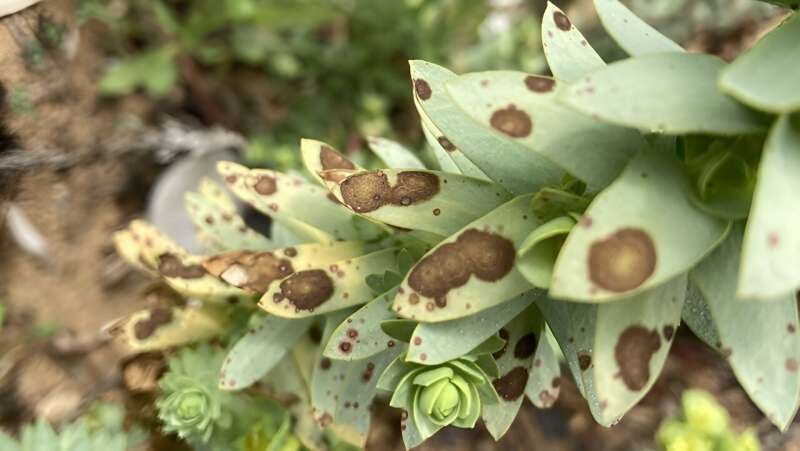This article has been reviewed according to Science X's editorial process and policies. Editors have highlighted the following attributes while ensuring the content's credibility:
fact-checked
trusted source
proofread
French fungus as a biocontrol agent against sea spurge in Australia

Field trials have confirmed the successful establishment of Venturia paralias, a biocontrol agent for sea spurge. This line in the sand marks the first time the fungus has established at release sites. It has now begun to spread.
Reducing sea spurge populations and spread will bring big biodiversity improvements for our native flora and fauna in coastal dune habitats.
Sea spurge is a serious environmental weed along the whole of Australia's southern coastline. It is found from Western Australia all the way around Tasmania to mid-New South Wales.
Its long-lasting seeds are carried on ocean currents and spread to new areas. Along the NSW south coast, sea spurge keeps re-invading sand dunes. It is progressively moving northward.
It threatens nesting sites of native shorebirds and little penguins (Edyptula minor). It displaces native plants and changes natural patterns of sand movement.
Sea spurge also reduces the amenity value of beaches due to its dense growth. When damaged it produces white latex, an irritant. This toxic latex can cause skin and eye irritations in animals as well as humans.
Many sea spurge infestations are in remote locations. This makes them difficult to manage by removing the weed by hand or using herbicides. Biocontrol offers a highly specific, sustainable, landscape-scale approach for sea spurge management.
Tackling the spurge scourge
We identified a targeted biological control agent for sea spurge: a fungus called Venturia paralias from France. It infects the leaves and stems of sea spurge, reducing its growth and reproduction.
We began by commissioning comprehensive host-specificity testing of the biocontrol agent. Their purpose was to confirm that the fungus, chosen to combat sea spurge, would not harm native plant species. After confirming the fungus was safe and only targeted sea spurge, it received approval for use in the environment.
Our senior research scientist, Gavin Hunter, was chief fungus dad and project lead.
"It's been such a good project. Working together with community groups and state agencies who are really invested in the success of this biocontrol agent has been so rewarding," Gavin said.
"We worked with Aboriginal Land Councils, Bushcare, Coastcare and Landcare, state government agencies, and the Sea Spurge Remote Area Teams (SPRATS) volunteer group in Tasmania and Victoria, to release the fungus in areas infested with this weed."
"There's no way we would have been able to have the high number of local release sites without the involvement of so many dedicated community groups and private individuals."
The release program across Tasmania and Victoria was supported by the New South Wales Government through its Environmental Trust.
Caroline Delaisse is a Research Technician with us. She said it was interesting trying to develop field application methods for the fungus.
"In the laboratory, we spread the fungus over a plate of agar to grow a 'lawn' of mycelium," Caroline said.
"We dry this out and package it into plastic tubes to mail out to community partners. They then mix it up in a solution to be sprayed onto sea spurge plants at release sites."

Fungus in the field
It is one thing to grow the biocontrol fungus in ideal conditions in the laboratory. It's much more complex out in the natural environment.
"In some places the biocontrol agent established really well. In others it waxes and wanes depending on local environmental conditions," Gavin said.
Until now the La Niña conditions of above average rainfall have been ideal for the fungus.
"Generally, we find that in spring and summer the levels of the fungus increase. Then the activity decreases as things cool down in autumn and winter. It overwinters in older lesions on the plants and rebounds as things warm up and there's more moisture," Gavin said.
"Over the past two years it's decreased the number of older plants. Now we're seeing younger plants come through from the seedbank in the soil as the population ages. It will be interesting to see how soon they're infected by the fungus and how it impacts them."
In total, the biocontrol agent has now been released at 182 sites across 40 locations by 26 registered community groups. So far, data from community participants confirms that the fungus has established at 60 release sites.
Now, our field surveys have confirmed the fungus has established in Tasmania.
We carried out detailed assessments across three monitoring sites in Tasmania during November 2022. We found the biocontrol agent was present in 62% of survey plots, with sea spurge plants showing leaf lesions from the fungus. In a follow up survey in June 2023 the biocontrol agent was found in 90% of the survey plots.
We also found the biocontrol agent had spread up to 250 meters from one of the monitoring sites to infect other sea spurge plants in the area. In fact, at this site it had to jump over a 50-meter-wide gap over the ocean so it's moving ahead in leaps and bounds.
Venturia in Victoria
The fungus has also been released by Parks Victoria at the world-renowned London Bridge, a natural offshore arch in Port Campbell National Park. This includes nesting sites for little penguins.
We conducted initial assessments seven months after the release. They showed the fungus had infected sea spurge plants at six dedicated monitoring spots around Victoria's coastline. Stem lesions were observed at all six spots and leaf lesions observed at five out of the six sites. The sea spurge plants at most of the plots showed decreased health.
The most recent field data is from October 2023. It confirmed that stem and leaf lesions were affecting sea spurge plants at all six monitoring sites. And surveys showed the biocontrol agent had naturally spread further afield at all of the monitoring sites.
Community groups spurgent mission
Community groups will be key for additional releases of the agent across Victoria and Tasmania. Community organizations involved in coastal weed management are encouraged to contact us to register and receive field release kits. You must have the necessary approvals from landowners and managers prior to doing so.
Provided by CSIRO




















